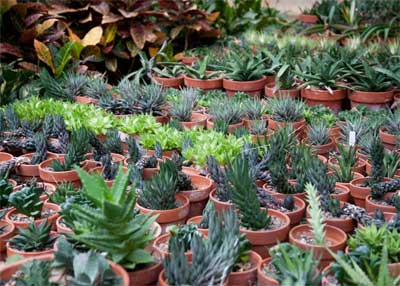From the Sperry Gardens – November, 2011

I’ve always loved haworthias and the other fine-textured succulents (including the hundreds of species of Aloes) of the huge lily family. I took this particular photo several years ago, at a time that these little beauties had been growing pretty much in these same pots for 18 years.
I have upwards of 400 species and varieties of these South African natives. They range in mature height from 1 to 8 inches, and they all share the trait of holding up wonderfully to hot and dry conditions. In fact, drainage is such an issue with them that I amend my lightweight potting soil with an additional 25 percent expanded shale. It couldn’t hold water very long if it had to. I’ve topped each pot with a quarter-inch layer of expanded shale to prevent splashing.

Two years ago, I burst open most of these clumps. I divided and repotted my old haworthias into their own individual 3- and 4-inch pots, and you can see a good assortment of them in the second photo taken this week. I’m not sure what I intend to do with 1,000 of them, but like so many things in my life, it seemed like a good idea at the time.

I have several personal favorites among this genus. Haworthia limifolia is one of them. You’ll notice its whorled leaf arrangement, spiraling around the plant’s axis. All of the offsets grow the same way, resulting in a pot filled with living pinwheels. And, the gene that produces this growth must be a dominant one, because all of the seedlings that come from this plant carry the same spiraling tendency.

Another favorite is H. truncata. Like cockscomb celosia and several other plants of different genera, its tissues grow in two dimentions only (height and length). The plants remain fan-shaped for their entire lives. And, as with the H. limifolia, the genes are strong. All offspring of this one stuggle to figure out how they’re supposed to grow – flat planes, or normally.

